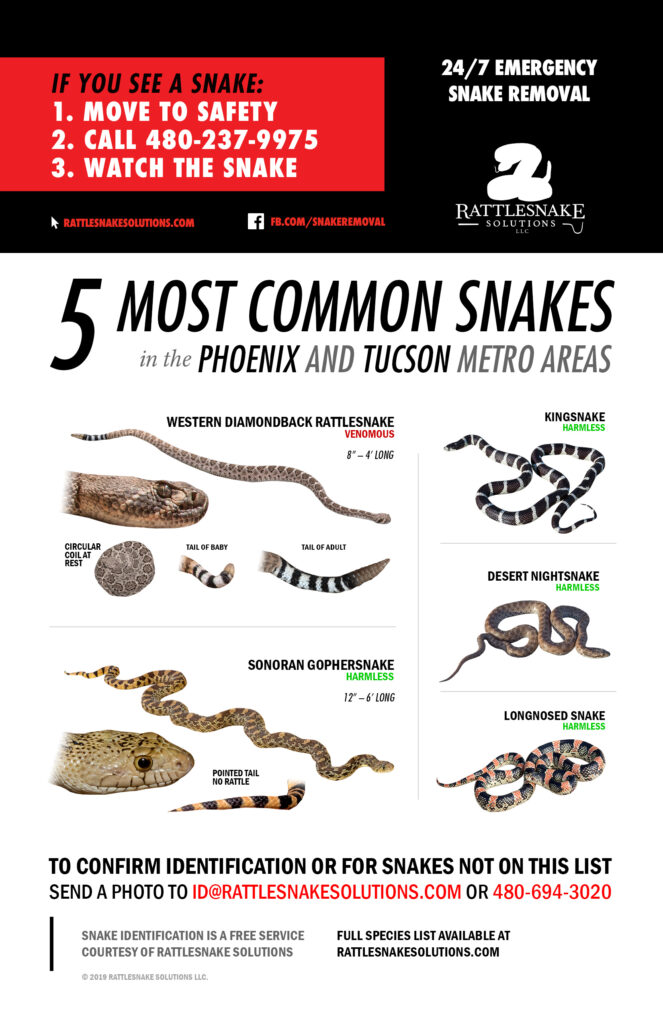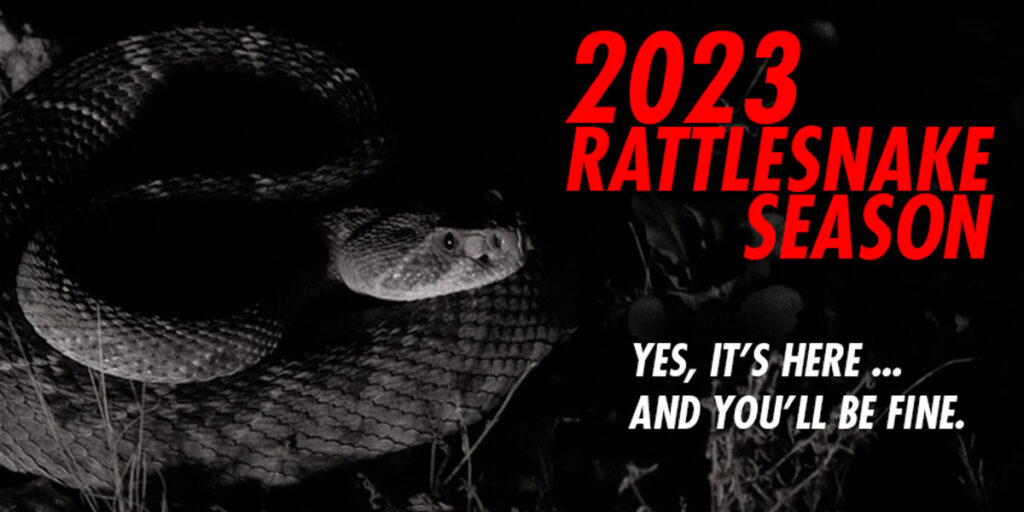Uncategorized
Arizona Rattlesnake Season 2023 Has Begun – What You Should Know
It’s really no surprise. After some extended Winter weather here in Arizona, things are starting to look like Spring. Wildflower photos are showing up all over social media feeds … and, of course, rattlesnakes.
Nope, they are not coming out early. If anything this year, they’re a little late. They’re not more aggressive, cranky, or other various local hyperbole. And, most of all: no, you are not in danger.
Before we get into the how’s and why’s, we’ll get right to the action items. Odds are at least some of you will be finding this while there’s literally a rattlesnake right in front of you, so we’ll get this out of the way.
If you need to have a rattlesnake removed from a property:
Call 480-237-9975 in Phoenix or 520-308-6211 in Tucson
If you have a snake that you need to have identified:
Text a photograph to 480-694-3020
What is Rattlesnake Season and when does it start?
While it is true that rattlesnakes can be encountered at any time of year in certain conditions, yearly activity spikes follow certain patterns. We define ‘rattlesnake season’ as the period where rattlesnake encounters with humans jump to peak activity, then die down again just as quickly in the Fall. In southern Arizona, this means, roughly mid-March through early November. This year, with the extra rain and cloud cover, we’re a little behind schedule … but all that is about to change, starting now.

The trigger we look for each year, according to our call volume and experience, is essentially this: when overnight temperatures stabilize in the 50s with daytime temperatures in the low 70s for a period of 3 or more days: it’s on. Rattlesnakes feel comfortable untethering from the protective dens where they’ve stayed near for the last several months.
You can watch this happen in real-time by watching the number of calls coming into our 24 hour snake removal hotline. We have created a tool to estimate current daily activity by the amount and velocity of snake removal requests. Watch how this changes over the next two weeks!
Rattlesnake Solutions Real-time Snake Activity Forecast

Why are there so many rattlesnake encounters in the Spring?
For a rattlesnake coming out of hibernation, there is a lot to do. After a long period without eating, rarely drinking, and conserving energy, rattlesnakes are looking to eat and drink as much as they can before things get too hot. This means they’ll be on the move to hunting areas, spending a lot of time on the move over the surface tracking prey and traveling.
This is also one of the mating periods for rattlesnakes. Along with the hunting activities, there are a lot of social tasks to do. Males are on the crawl looking for females to court and mate with … and on the lookout for rival males. Rattlesnakes are very social animals, and these periods of reasonable weather are when many of the activities that help define hierarchy will take place in a short period of time.
But an encounter with a rattlesnake takes two: the snake of course, and the person or pet who encounters it! These same mild conditions are when Arizona residents take to the trails by the thousands to look at flowers and take in all the Sonoran Desert has to offer before temperatures hit triple digits. This is also the time to get to those landscaping and gardening projects, clean out the garage, and all fun stuff that comes with t-shirt weather.
All of this adds up to this: both rattlesnakes and humans are suddenly at peak levels of outdoor activity at the same time. We will, of course, cross paths from time to time.
https://www.youtube.com/embed/aQs8LJlEM5c?feature=oembedLearning about rattlesnakes can help fear go away and keep you safe.
If you fear rattlesnakes and dread this time of year, there is good news.
Fear of rattlesnakes is real. You feel it, and there’s not a single thing that someone can tell you that will make that go away.
But, if this fear is not something you want, and you’re sick of feeling like this every Spring, there are things you can do about it. This varies from person to person, of course, but consistently: learning more about the things you fear can help. For many, even looking at a photo of a rattlesnake can invoke panic, but it’s a safe place to start.
Here’s a guide to help the snake-phobic among us get on that path to feeling better about it. We have watched many people go from terrified to fascinated, and it’s possible for you to as well.
Scared of Rattlesnakes? Mental Preparation for Rattlesnake Season
Does rattlesnake season mean I should stop hiking?
Not at all. For as much as we worry about rattlesnakes, the fact is that the situation is nowhere near as dangerous as seems in our minds. Rattlesnakes want to avoid us every bit as much as we want to avoid them, and to that end, you are allies. Accidental bites, where the incident is not provoked intentionally by the victim, are quite rare even in Arizona. Typically, there are fewer than 300 in any given year, and ZERO deaths.
Follow basic rattlesnake awareness and avoidance guidelines and it is not at all hard to be safe during rattlesnake season. For full details, check out our Arizona Hikers’ Guide to Rattlesnake Safety
Remember:
- Rattlesnakes are not aggressive; they will not chase, jump, or come after you to ‘get’ you. If one is rattling, it’s scared of you and wants you to go away. Do it!
- Learning about the subject you fear will help make it more reasonable. Do what you can to educate yourself, as you are doing right now, about rattlesnakes and what they do and don’t do.
- Keep your hands and feet where you can see them at all times. Your eyes are your best tool to avoid rattlesnakes.
- Stay on trails and avoid bushwhacking whenever possible.
- Keep dogs on leashes at all times in the outdoors.
- Don’t wear headphones or listen to music while hiking. Rattlesnakes have a built-in warning system, but it doesn’t work if you can’t hear it!
- Don’t touch, capture, or kill snakes that you see … and keep others from doing the same.
- Have a plan. All you need in the event of a bite is to call 911. If that’s not possible, use your satellite messaging device.
What should homeowners know about rattlesnakes?
While hikers and campers might expect to see a rattlesnake out there, most homeowners do not plan on it. Especially for new residents of the state, how to handle the possibility of a rattlesnake showing up on the doorstep may seem daunting.
First, evaluate the actual chances of seeing a rattlesnake in your yard. It’s not just as simple as to assume that houses near the desert have more rattlesnake encounters. Where in the neighborhood a home is can have even more of an effect. For example: homes on the corners and ends of streets can see far more rattlesnakes than those on the interior.
Homeowners might also want to take note of which snake species can show up at your place. We know not everyone is into nature and spending a lot of time learning all of the different types of snakes in Arizona is just … too much. So, keep this on your phone:

This is also a great time to think about prevention. If you live in an area where rattlesnakes can be, it is likely that at some point one will show up. Things like habitat reduction, rattlesnake fencing, and proper maintenance make a huge difference in the likelihood of rattlesnake encounters at a home.
When will snake activity decrease again?
Just as we might disappear when temperatures climb into the triple digits, snakes will as well. Or at least, they’ll start to become more nocturnal and less likely to be encountered by most people. This is nowhere near the low level of activity that we have in the Winter, but it’s certainly less than it will be in April.
That should happen around mid-May. Rattlesnakes will be moving to aestivation shelters to wait out the hot and dry, waiting for the monsoon rain. During that time, there are still encounters, but it’s quite different, and we’ll provide further updates when we get there.
In the meantime, keep hiking, enjoy the weather, and get outside! It’s great outside and you want to be in it; you and rattlesnakes have something in common.

